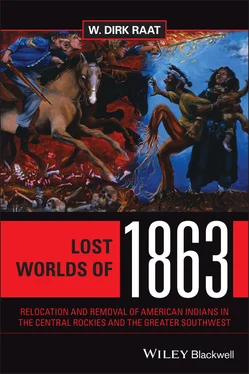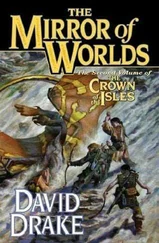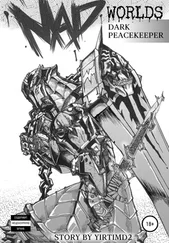The boarding school section of the mural was informed by my elder relatives’ horror stories of being forced to conform to Western Culture in Boarding Schools. Schools, where the goal was, as Captain Richard Henry Pratt is quoted in the commentary following Chapter 2(“The Military and the Boarding School”), “Kill the Indian … and save the man.”
In the late spring of 2000, I completed the mural, “Fear of a Red Planet: Forced Removal and Relocation.” “Fear of a Red Planet” was added into the title after overhearing Craig Smith, the Museum photographer, comment about how potentially challenging some of the imagery I created could be for some Heard members. I added “Fear of a Red Planet” to the title as I realized so much colonization and conflict are rooted in the fear of the unknown and the inability for dominant cultures to acknowledge its own amnesia of progress.
“Amnesia of progress” is a phrase that is stenciled in the mural. It was coined by the writer Jonathan Bond, a close friend and frequent collaborator. The phrase is well suited to the subject matter of “Fear of a Red Planet: Forced Removal and Relocation;” that of forced migration and extinction of a people for the benefit of a dominant culture, with no credence for the human cost.
“Fear of a Red Planet” is also an indirect reference to a mockumentary called “Fear of a Black Hat,” a comedy about the rise and fall of the controversial musical group N.W.A. (Niggaz Wit Attitudes). “Fear of a Black Planet” is the title of N.W.A.’s most famous album; the reference in the Mural title to both “Black Hat” and “Black Planet” is about the co-mingling of parody and fear, which is how the dominant culture relates to groups in the minority.
The story of forced relocation and removal is a major theme in Raat’s Lost Worlds of 1863 . Raat has expanded on the relational aspects of numerous activities and atrocities that coincided around the 1860s, a pivotal and momentous time in our collective histories. While the mural I painted “Fear of a Red Planet: Forced Removal and Relocation” looks into this time period a great deal, it is only a piece of the greater story.
Colonization and imperialism remain a painful memory, but an essential one for us to learn from if we can. Raat’s Lost Worlds of 1863 draws us closer to what is at stake between all cultures and people on this planet. By focusing on this period his work sheds new light on the complexities at play at a pivotal time in our not too-distant past.
Steven Jon Yazzie
Phoenix, Arizona
As enemies, the Mexicans were nothing in comparison with the White Eyes who came in from the east . White Eyes is not the exact meaning of our word for them; a more exact meaning would be Pale Eyes .
Ace Dalugie, patriarch of the Mescalero Reservation, Son of Juh, Leader of the Nednhi Apache
This is a history about the relationship between what Apache patriarch Ace Dalugie called the Pale Eyes and their opposite numbers, the “redskins” as the Pale Eyes derisively called them. Whites or Pale Eyes usually had a skin color that was not white but flesh colored or a light brownish pink color. As for the “redskins,” they were seldom only red but ranged in skin color from a dull yellowish brown (khaki) or a light grayish brown (beige) to bronze and reddish-brown.
Only the caste system the whites brought with them dictated a false dichotomy between being “white” and “red,” with the “redskins” being assigned the external and subordinate role that racism and casteism required. The history of the Greater Southwest is one in which “whites” maintained the illusion of their superiority by dehumanizing indigenous peoples. As social and cultural historian Gary Michael Tartakov noted, “It [they] dehumanized others to build its [their] own civilization.” 1
The relationship between “whites” and “redskins” involved a more diverse group than even Dalugie noted. Prior to and after the Civil War many blacks and ex-slaves came west as cowboys, miners, and soldiers, as did Chinese workers, as well as Mexicans, mulattos and indios from the southern and eastern states (including those individuals who were African-Native Americans). The diversity involved members of both sexes, including females as mothers (including single, divorced, and widowed), pioneers, farmers, cowgirls and ranchers, prostitutes, housekeepers, property owners, entrepreneurs, headwomen, scouts, homesteaders, educators, and warriors. In any case, these were the antagonists that were involved in a major drama of the nineteenth century, the relocation and removal of indigenous societies in the Greater American Southwest. The book is entitled Lost Worlds of 1863 and the drama of relocation centers around that pivotal date in western history.
The inspiration for this work comes both from my activity as a docent at the Heard Museum in downtown Phoenix, Arizona, as well as a vacation trip I took in the summer of 2012. That summer, my wife and I, accompanied by our dog Nacho, drove through Owens Valley on our way to Lake Tahoe to visit our children and grandchild. On the way I noticed a historical marker commemorating the removal of several hundred Owens Valley Paiutes to Fort Tejon. This military reservation was located across the Sierra Nevada between the Los Angeles Basin and the Central Valley. I noted to my wife that this was the same year Kit Carson and his military allies forcibly began to remove several thousand Navajos from northeastern Arizona to central New Mexico. This coincidence led me to investigate further the significance of “1863” and this book is the result of that inquiry.
The primary theme of this work has been derived from a mural painted by the Navajo artist Steven Jon Yazzie that is in the collection of the Heard Museum in downtown Phoenix, Arizona. In the year 2000, Yazzie spent more than six months creating a mural that illustrated the diaspora experience of tribal peoples in the Greater American Southwest. These tales speak of the removal and assimilation policies of the United States government (or in the case of the Yaqui, the Mexican regime of Porfirio Díaz) vis-à-vis the southwestern indigenous populations, and the resulting uprooting of indigenous peoples from land and family. The Yazzie mural covered three walls in the Ullman gallery and focused on the nineteenth century stories of the Navajo, Yaqui, and Colorado River people, as well as the boarding school period that began in 1878. Yazzie’s mural is entitled “Fear of a Red Planet: Relocation and Removal,” and was the motivating force behind the current work.
There are many ways to parcel up the past. Some historians talk about historical periods, such as the Age of Reason or the Cold War era. Others speak of centuries, generations, or decades—all terms of convenience. The most daring and enjoyable histories are those that proclaim that the course of human events centered on a particular year, with 1492 an especially appealing year. According to Louis Menand, writing in The New Yorker , these are known as one-dot histories. 2Those books with one-year titles are melodramatic and somewhat ahistorical. So let me assure the reader that the one-dot theory of history does not apply in the present case.
This study concentrates on the nineteenth century history of the Indians of the Greater American Southwest. The year “1863” receives special note, but only as a “hook” or focal point that allows the reader and scholar to experience and interpret the events that took place before and after that date. The events of that year are not necessarily a precursor to those that follow, or the consequence of what went before. The year “1863” is simply one window into the past where one can see several locales and tribal groups and events associated with those locales. As for the geographical area, it is called the Greater Southwest, a region that extends beyond the current boundaries of Arizona and New Mexico to include the Mexican states of Sonora and Chihuahua, and reaches as far as the northern boundaries of California, Nevada, and Utah (as well as the Great Basin area of southern Idaho). These two ideas will be further developed in the introduction.
Читать дальше












